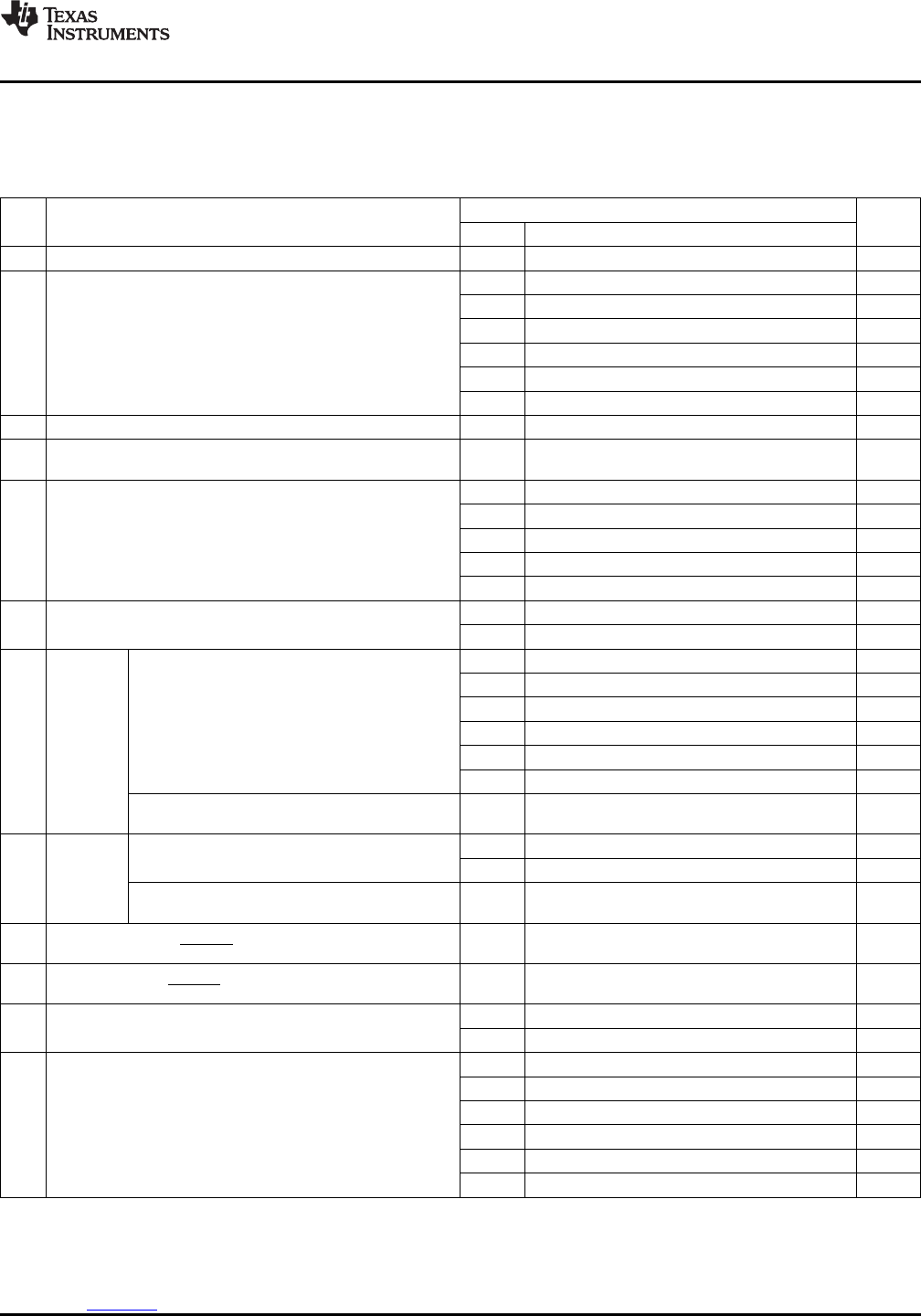Datasheet
Table Of Contents
- 1 Digital Media System-on-Chip (DMSoC)
- Table of Contents
- 2 Revision History
- 3 Device Overview
- 3.1 Device Characteristics
- 3.2 Device Compatibility
- 3.3 ARM Subsystem
- 3.3.1 ARM926EJ-S RISC CPU
- 3.3.2 CP15
- 3.3.3 MMU
- 3.3.4 Caches and Write Buffer
- 3.3.5 Tightly Coupled Memory (TCM)
- 3.3.6 Advanced High-Performance Bus (AHB)
- 3.3.7 Embedded Trace Macrocell (ETM) and Embedded Trace Buffer (ETB)
- 3.3.8 ARM Memory Mapping
- 3.3.9 Peripherals
- 3.3.10 PLL Controller (PLLC)
- 3.3.11 Power and Sleep Controller (PSC)
- 3.3.12 ARM Interrupt Controller (AINTC)
- 3.3.13 System Module
- 3.3.14 Power Management
- 3.4 DSP Subsystem
- 3.5 Memory Map Summary
- 3.6 Pin Assignments
- 3.7 Terminal Functions
- 3.8 Device Support
- 3.9 Documentation Support
- 3.10 Community Resources
- 4 Device Configurations
- 4.1 System Module Registers
- 4.2 Power Considerations
- 4.3 Clock Considerations
- 4.4 Boot Sequence
- 4.5 Configurations At Reset
- 4.6 Configurations After Reset
- 4.7 Multiplexed Pin Configurations
- 4.7.1 Pin Muxing Selection At Reset
- 4.7.2 Pin Muxing Selection After Reset
- 4.7.3 Pin Multiplexing Details
- 4.7.3.1 PCI, HPI, EMIFA, and ATA Pin Muxing
- 4.7.3.2 PWM Signal Muxing
- 4.7.3.3 TSIF0 Input Signal Muxing (Serial/Parallel)
- 4.7.3.4 TSIF0 Output Signal Muxing (Serial/Parallel)
- 4.7.3.5 TSIF1 Input Signal Muxing (Serial Only)
- 4.7.3.6 TSIF1 Output Signal Muxing (Serial Only)
- 4.7.3.7 CRGEN Signal Muxing
- 4.7.3.8 UART0 Pin Muxing
- 4.7.3.9 UART1 Pin Muxing
- 4.7.3.10 UART2 Pin Muxing
- 4.7.3.11 ARM/DSP Communications Interrupts
- 4.7.3.12 Emulation Control
- 4.8 Debugging Considerations
- 5 System Interconnect
- 6 Device Operating Conditions
- 7 Peripheral Information and Electrical Specifications
- 7.1 Parameter Information
- 7.2 Recommended Clock and Control Signal Transition Behavior
- 7.3 Power Supplies
- 7.4 External Clock Input From DEV_MXI/DEV_CLKIN and AUX_MXI/AUX_CLKIN Pins
- 7.5 Clock PLLs
- 7.6 Enhanced Direct Memory Access (EDMA3) Controller
- 7.7 Reset
- 7.8 Interrupts
- 7.9 External Memory Interface (EMIF)
- 7.10 DDR2 Memory Controller
- 7.10.1 DDR2 Memory Controller Electrical Data/Timing
- 7.10.2 DDR2 Interface
- 7.10.2.1 DDR2 Interface Schematic
- 7.10.2.2 Compatible JEDEC DDR2 Devices
- 7.10.2.3 PCB Stackup
- 7.10.2.4 Placement
- 7.10.2.5 DDR2 Keep Out Region
- 7.10.2.6 Bulk Bypass Capacitors
- 7.10.2.7 High-Speed Bypass Capacitors
- 7.10.2.8 Net Classes
- 7.10.2.9 DDR2 Signal Termination
- 7.10.2.10 VREF Routing
- 7.10.2.11 DDR2 CK and ADDR_CTRL Routing
- 7.11 Video Port Interface (VPIF)
- 7.12 Transport Stream Interface (TSIF)
- 7.13 Clock Recovery Generator (CRGEN)
- 7.14 Video Data Conversion Engine (VDCE)
- 7.15 Peripheral Component Interconnect (PCI)
- 7.16 Ethernet MAC (EMAC)
- 7.17 Management Data Input/Output (MDIO)
- 7.18 Host-Port Interface (HPI) Peripheral
- 7.19 USB 2.0 [see Note]
- 7.20 ATA Controller
- 7.21 VLYNQ
- 7.22 Multichannel Audio Serial Port (McASP0/1) Peripherals
- 7.23 Serial Peripheral Interface (SPI)
- 7.24 Universal Asynchronouse Receiver/Transmitter (UART)
- 7.25 Inter-Integrated Circuit (I2C)
- 7.26 Pulse Width Modulator (PWM)
- 7.27 Timers
- 7.28 General-Purpose Input/Output (GPIO)
- 7.29 IEEE 1149.1 JTAG
- 8 Mechanical Packaging and Orderable Information

TMS320DM6467T
www.ti.com
SPRS605C –JULY 2009–REVISED JUNE 2012
7.20.3.3 ATA Ultra DMA Timing
Table 7-92. Timings for ATA Module — Ultra DMA AC Timing
(1) (2)
(see Figure 7-66 through Figure 7-75)
-1G
NO. UNIT
MODE MIN MAX
28 f
(SYSCLK4)
Operating frequency, SYSCLK4 0-5 25 MHz
0 240 ns
1 160 ns
2 120 ns
1 t
2CYCTYP
Typical sustained average two cycle time
3 90 ns
4 60 ns
5 40 ns
2 t
CYC
Cycle time, Strobe edge to Strobe edge 0-5 (UDMASTB + 1)P ns
Two cycle time, rising to rising edge or falling to
3 t
2CYC
0-5 2(UDMASTB + 1)P ns
falling edge
0 15 ns
1 10 ns
4 t
DS
Data setup, data valid before STROBE edge 2-3 7 ns
4 5 ns
5 4 ns
0-4 5 ns
5 t
DH
Data hold, data valid after STROBE edge
5 4.6 ns
0 70 ns
1 48 ns
2 31 ns
Data valid INPUT setup time, data valid before
STROBE
3 20 ns
6 t
DVS
4 6.7 ns
5 4.8 ns
Data valid OUTPUT setup time, data valid before
0-5 (UDMASTB)P - 3.1 ns
STROBE
0-4 6.2 ns
Data valid INPUT hold time, data valid after
STROBE
5 4.8 ns
7 t
DVH
Data valid OUTPUT hold time, data valid after
0-5 1P - 2 ns
STROBE
CRC word valid setup time at host, CRC valid
10 t
CVS
0-5 P ns
before DMACK negation
CRC word valid hold time at sender, CRC valid
11 t
CVH
0-5 2P ns
after DMACK negation
0-4 0 ns
Time from STROBE output released-to-driving
12 t
ZFS
until the first transition of critical timing
5 35 ns
0 70 ns
1 48 ns
2 31 ns
Time from data output released-to-driving until
13 t
DZFS
the first transition of critical timing
3 20 ns
4 6.7 ns
5 25 ns
(1) P = SYSCLK4 period, in ns, for ATA. For example, when running the DSP CPU at 1 GHz, use P = 7 ns.
(2) UDMASTB equals the value programmed in the UDMSTBxP bit field in the UDMASTB register. UDMATRP equals the value
programmed in the UDMTRPxP bit field in the UDMATRP register. TENV equals the value programmed in the UDMATNVxP bit field in
the UDMATENV register. For more detailed information, see the TMS320DM646x DMSoC ATA Controller User's Guide (literature
number SPRUEQ3).
Copyright © 2009–2012, Texas Instruments Incorporated Peripheral Information and Electrical Specifications 285
Submit Documentation Feedback
Product Folder Link(s): TMS320DM6467T










